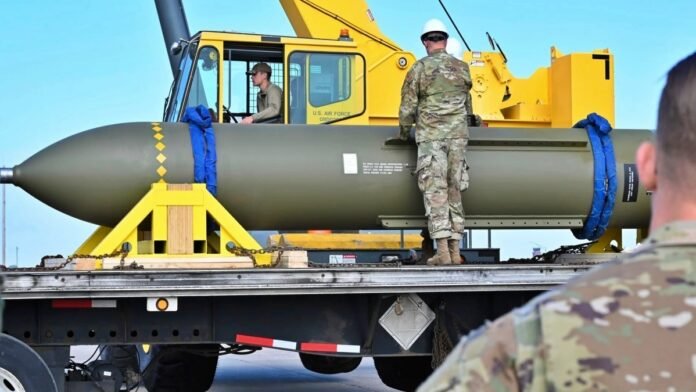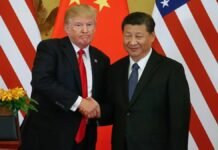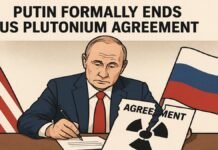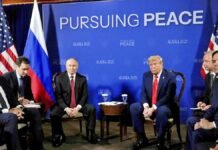
Key Points
- Israel’s recent strike on Iran targeted its nuclear program but failed to destroy the deeply-buried Fordow enrichment facility.
- Fordow is shielded by 80–90 meters of hard rock and reinforced concrete, making it nearly impervious to conventional or Israeli bunker-buster bombs.
- Only the U.S. GBU-57 Massive Ordnance Penetrator, delivered by B-2 Spirit stealth bombers, is considered capable of reaching and potentially destroying Fordow.
- Experts say multiple GBU-57 bombs, dropped in succession, would be required for a successful strike.
- The U.S. has recently increased military readiness in the region, with B-2 bombers and refueling aircraft deployed to Diego Garcia, signaling possible preparations for long-range strikes.
New Delhi: Israel’s latest military action against Iran aimed to cripple Tehran’s nuclear ambitions. While Israeli forces reportedly damaged several nuclear sites, the Fordow Fuel Enrichment Plant a linchpin of Iran’s uranium enrichment program remains intact. This is because Fordow is buried 80–90 meters (260–295 feet) beneath a mountain near Qom, protected by layers of volcanic rock and reinforced concrete, making it one of the world’s most fortified nuclear sites.
Why Fordow Is Nearly Impenetrable
Fordow’s design is a direct response to threats of airstrikes:
- Depth: 80–90 meters underground, with additional concrete shielding.
- Geology: Built into exceptionally hard volcanic rock, similar to the Tibetan plateau, providing natural protection beyond what most munitions can breach.
- Defenses: Advanced air defense systems and internal reinforcements further shield the facility.
Israeli munitions, including their most advanced bunker busters, cannot reach Fordow’s main chambers. At best, they might damage entrances or ventilation shafts, but the core enrichment halls housing thousands of centrifuges would survive.
The GBU-57: America’s ‘Bunker Buster’ Bomb
Only the U.S. possesses the GBU-57A/B Massive Ordnance Penetrator (MOP), a 30,000-pound (13,600 kg) precision-guided bomb specifically engineered to destroy deep underground bunkers like Fordow.
Key Specs:
- Weight: 30,000 pounds (13,600 kg)
- Length: 6.2 meters (20.5 feet)
- Explosives: 2,500–5,000 kg of high-performance explosives
- Penetration: Up to 60 meters (200 feet) of reinforced concrete or hard rock
- Delivery: Only the U.S. Air Force’s B-2 Spirit stealth bomber can carry and deploy the GBU-57, with each bomber able to carry two bombs per mission.
Would One Bomb Be Enough?
Experts agree that even the GBU-57 may not destroy Fordow in a single strike. The bomb’s effectiveness depends on:
- Precise Targeting: Multiple bombs must be dropped in rapid succession into the same breach to reach and devastate the core centrifuge halls.
- Geological Complexity: Fordow’s hard rock and internal reinforcements could deflect or absorb the energy of a single bomb, making sequential strikes essential.
- Operational Complexity: Such an operation would require coordination, aerial refueling, and potentially multiple B-2 bombers, which have recently been stationed at Diego Garcia, a key U.S. base within striking distance of Iran.
U.S. Military Readiness and Regional Escalation
Recent movements of U.S. military assets including B-2 bombers, B-52s, and over two dozen aerial refueling tankers to Diego Garcia and other regional bases suggest heightened readiness for potential long-range strikes.
However, deploying the GBU-57 would mark a major escalation, risking broader conflict and drawing the U.S. directly into the Israel-Iran confrontation.
Strategic and Political Stakes
While Israel claims it can achieve its objectives independently, most military analysts assert that only U.S. intervention, with its unique bunker-busting capability, could truly threaten Fordow’s survival. Even then, success is not guaranteed, and the consequences for regional stability could be profound.
Israel’s attack exposed the limits of its arsenal against Iran’s most protected nuclear site. The fate of Fordow and the future of Iran’s nuclear program now hinges on whether the U.S. is willing to deploy its most powerful conventional weapon, the GBU-57, in a move that could reshape the Middle East’s security landscape.


















































